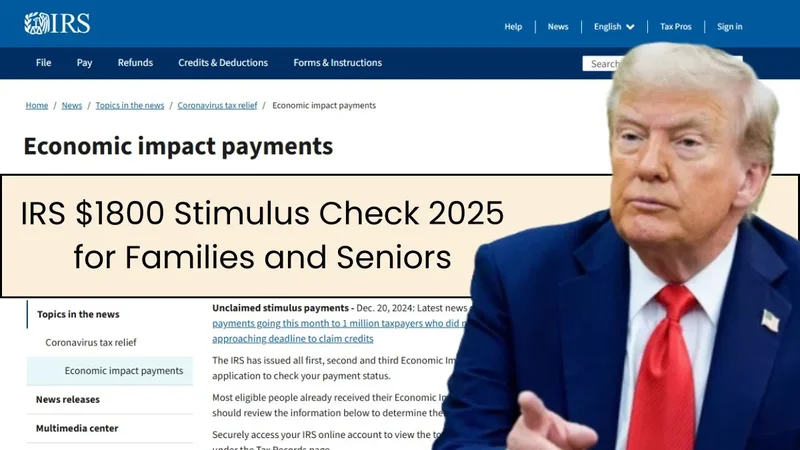It’s a familiar ghost in the machine of social media: a bold headline promising a "$2,000 Stimulus Check Confirmed for 2025." You see it flash across your screen, sandwiched between a vacation photo and a political rant. For a moment, the numbers feel real. The possibility feels tangible. And then, like a market anomaly that corrects itself, the rational part of your brain kicks in, asking the only question that matters: where is the data to support this?
Let’s be clear. The online chatter about a fourth federal stimulus check is a masterclass in narrative over substance (Are we getting a stimulus check in 2025? IRS tax refund status tracker, rebate eligibility). We’ve seen figures floated—$1,390, $1,702, even a clean $2,000—all without a single piece of approved legislation or an official IRS announcement to back them. These are phantom numbers, propagated by click-hungry websites and scammers looking to harvest your personal information.
The COVID-era stimulus programs are over. The deadline to claim the third and final payment, the $1,400 Recovery Rebate Credit for 2021, was April 15, 2025. That window is closed, and any unclaimed funds have been absorbed back into the U.S. Treasury. The data set on that chapter of fiscal policy is complete. So why does the ghost of free money persist? Because the economic anxiety is real, and the political incentive to acknowledge it—without committing to a solution—is powerful.
When you filter out the unsubstantiated rumors, you’re left with a handful of federal-level ideas that are, to be frank, more speculative than substantive. We have the "American Worker Rebate Act," a bill from Senator Josh Hawley that proposes checks ranging from $600 to $2,400. It’s a concrete proposal, yes, but it remains just that: a proposal that has not navigated the labyrinth of Congress. Its probability of passage is, at this point, statistically negligible.
Then you have the more ephemeral concepts floated during campaign season. Donald Trump mentioned a "tariff rebate," an idea to return revenue from new tariffs to taxpayers. He also mused about a "$5,000 DOGE dividend," a payout derived from savings identified by a theoretical "Department of Government Efficiency." I've analyzed countless corporate projections in my time, and the language used here feels eerily similar to a pre-revenue startup's pitch deck—all promise, no discernible pathway to execution. These aren't policy; they're trial balloons launched to gauge public sentiment.
This entire federal narrative is like chasing ghost signals in stock market data. You see a pattern that looks promising, a spike that suggests a breakout, but when you apply rigorous analysis, you realize it’s just noise. The real, actionable information isn't found in these grand, national pronouncements. It’s buried in the much less exciting, but far more tangible, world of state tax code.

While Washington debates phantom checks, several states are quietly executing their own relief programs. This is where the actual money is flowing, but it’s crucial to understand what this money is—and what it isn’t. It’s not a "stimulus" in the classic sense of a broad, federally funded injection to boost the economy. It is, almost universally, a form of targeted tax relief. The distinction is critical.
Take New York’s School Tax Relief (STAR) program. This is a well-defined, data-rich initiative. In 2025, it’s distributing over $2.2 billion to roughly 3.3 million households. The payments are specific and tiered: Basic STAR for homeowners with incomes up to $250,000, and Enhanced STAR for seniors (age 65+) with incomes under a much lower threshold ($98,700, based on 2022 income). The checks themselves range from about $350 to as much as $1,500 for eligible seniors (Confirmed — $1,500 Stimulus Check Payment 2025 For All, Check How the STAR Program Helps). This isn’t a hypothetical; it’s a budgeted, targeted rebate with clear eligibility criteria.
This model, or a variation of it, is the real story of financial relief in 2025. New Jersey has its ANCHOR program, providing up to $1,750 in property tax relief for senior homeowners. Pennsylvania, Georgia, and Colorado have rolled out similar rebate checks tied to inflation or property taxes.
What does this data tell us? It reveals a fundamental disconnect. The national conversation is stuck on a simple, powerful, but fictional idea—a single check from the IRS. The reality is a complex mosaic of dozens of different state-level programs, each with its own rules, income caps, and payment schedules. Conflating a New York property tax credit with a federal stimulus check isn't just inaccurate; it's misleading. Why is no one making this distinction clear? And how much financial confusion is caused by politicians using the term "stimulus" to describe what is essentially a state tax refund?
Let's cut through the noise. The probability of the U.S. Congress authorizing and distributing a fourth universal stimulus check in the current political and economic climate is functionally zero. The narrative is a political tool, not a fiscal plan.
The real financial relief being offered to Americans is smaller, more targeted, and happening at the state level. It’s not as exciting as a $2,000 check appearing in your bank account, but it’s real. My analysis suggests that anyone waiting for a directive from the White House or the IRS is looking through the wrong end of the telescope. The most valuable financial information for your family right now won’t be found on a national news broadcast, but on your state’s department of revenue website. Stop chasing ghosts and start reading the footnotes. That’s where the money is.